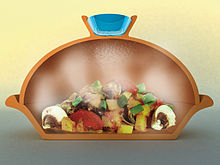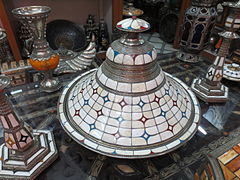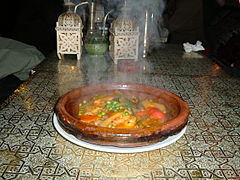Tagine
The (also the) Tajine , Tagine or Taschiin ( Arabic طاجن, DMG ṭāǧin , pl.طواجن / ṭawāǧin , “ casserole ”, pronunciation: [ taˈdʒiːn ] or [ tæˈʒiːn ]) in North African cuisine denotes both a round, clay stew vessel with a domed or pointed (conical) lid and the dish cooked in it.
functionality
Like other pressure cooker systems, the traditional clay cooker from Morocco works as follows: The ceramic base material - clay or heavily leaned clay - is burned at a low temperature during manufacture ( earthenware ), which is why a tagine does not crack when there is an abrupt change in temperature. With its relatively thick wall, the vessel also protects the food from burning and transfers the heat evenly so that the contents are cooked gently. The ingredients are placed on top of each other in the pot; the pointed (Arabic) or domed (Berber) lid ensures that the heat stays evenly for a long time. The ceramic firing process and the structure can be found in a similar design in many cultures.
The lid ends in a bowl or a hollow in which water is poured before cooking. This creates a kind of vapor barrier in the ceramic wall of the vessel. The steam condenses , runs off into the bowl of the food and then rises again as steam. Through this cycle, the contents are cooked gently ; the food stews in its own juice. The steam comes from the ingredients themselves; liquid is added for dry ingredients. The bowl is also shaped like a handle: the lid stays cool in place and you can lift it off without tools.
There are now tajines that are suitable for use on normal hotplates and ceramic hobs because of their smooth bases. In the case of gas flames, ensure that the flame is evenly distributed over a large area, as uneven, strong heat can lead to cracks. To avoid damage, the food is cooked longer on a lower heat.
Tajines are glazed or available with a natural, rough surface. With glazed tajines, care must be taken that the glaze does not contain lead - as was common in the past. Both traditional and modern tajines made of glazed material are available. A glazed tagine is easier to clean and absorbs the aroma of the food less than natural variants. However, there is always the risk that cracks will form in the glaze over time.
A traditional tagine without glaze is soaked in water for a few hours before first use and then "boiled down" with oil, some water and vegetables. It forms a patina , a natural "non-stick coating" on the floor, which partially closes the pores of the ceramic. If you later water the bowl and lid before cooking, the still quite open-pored ceramic of the lid hardly absorbs any water vapor and ensures a uniformly moist cooking climate inside. The cleaning is done with a sponge without chemical aids.
- Vessel shapes
use
For stews in North Africa, the tajine is traditionally placed on a charcoal fire. You can also use the tagine in the oven, then the cooking process is similar to that in the Roman pot . In North African cuisine, hearty dishes with meat and fish as well as desserts with the tagine are prepared. The tagine is placed on the table for serving and the guests help themselves directly from the ceramic pot.
The tagine is also sold in Europe. This changes the recipes: Most of the books available on the market still contain oriental and Moroccan recipes for the tagine. In the course of an increasingly international culinary culture, there are also recipes from Asia, South America, vegetarian suggestions and even German recipes.
literature
- Ghillie Başan: Tajines - really Moroccan & simply delicious. Hädecke, Weil der Stadt 2020, ISBN 978-3-7750-0791-7 .
- Elisabeth Döpp: Oriental cuisine. Over 100 original recipes for oriental enjoyment: mezze, tajines, couscous and more. Gräfe and Unzer, Munich 2006, ISBN 978-3-8338-0080-1 .
- Isabelle Dreyfus: Tajine. Recipes from the clay pot. Hädecke, Weil der Stadt 2004. ISBN 978-3-7750-0445-9 .
- Christin Kasri, Mohammad Ali Kasri: Bismillah. Oriental delicacies from Morocco's kitchens. Neue Umschau, Neustadt ad Weinstrasse 2005, ISBN 3-86528-226-1 .
- Alain Jaouhari: Morocco. 90 recipes. Christian, Munich 2002, ISBN 3-88472-682-X .
- Jochen Walter: Tajine vegetarian. 100 international recipes from the clay pot. Christian, Munich 2014, ISBN 978-3-86244-572-1 .
Web links
Individual evidence
- ↑ Entry Tajine in the online Duden, accessed on March 5, 2018
- ↑ entry tajine on dictionary.com, accessed on March 5, 2018
- ↑ tagine recipes , Basan, p 6, Harms, S. 22, Lagunaoui, S. 143rd
- ↑ See on the use of a natural tagine without glaze: Walter 2011, p. 11–15, also Walter 2014. For an introduction to the definition and use of the tagine in general: Başan, p. 6 f., Lutz, p. 29 f., Morse, p. 29, Seguin-Tsouli, p. 12 f., Kasri, p. 92 f., Lauterbeck, p. 148, Roden, p. 29 f.
- ↑ Dreyfus 2004, Walter 2011, Walter 2014.





